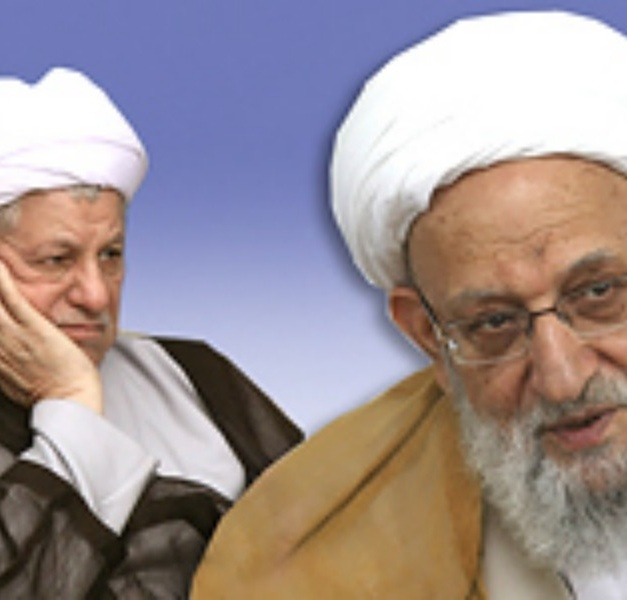 Rafsanjani and Mahdavi-KaniMr Tehrani analyses for EA:
Rafsanjani and Mahdavi-KaniMr Tehrani analyses for EA:
The replacement of Hashemi Rafsanjani at the helm of the Assembly of Experts has provoked a flurry of analysis and commentary. The former president’s rather humiliating retreat from the position he coveted and held since 2007 --- a tenure considerably smaller than the 23 years of his predecessor, Ayatollah Meshkini, who died in office --- has been highlighted by most commentators as a setback for Rafsanjani, whose power and clout within the state system had been eroding since he failed to regain the Presidency in 2005 and had declined further and faster after the 2009 elections.
However, in this coverage, the extent of the ideological and personal differences between Rafsanjani and Ayatollah Mahdavi Kani, the new head of the Assembly, have been left in the shade. This has allowed the hypothesis to emerge, mainly as a damage-limitation exercise by Rafsanjani supporters, that the two made a tacit deal to stave off the challenge of maverick radical clerics, such as Ayatollah Mesbah Yazdi,linked to the Ahmadinejad-Revolutionary Guards combination.
A closer examination of the political past of both Rafsanjani and Mahdavi Kani casts significant doubts on the validity of this thesis, which has forward by Rafsanjani supporters and loyalists as a damage-limitation exercise.
For more than 30 years, Mahdavi Kani has been a silent schemer, the head of the Combatant Clerics’ Association. The CCA was a loose and informal cluster of clerics, strictly loyal to Ayatollah Khomeini, which was formed at the twilight of the Shah’s rul, in the late 1970s to bring together the mosque networks which had sprung up across the country in support of Khomeini. Known for his organisational skills, honed while in charge of the crucial Jalili mosque in central Tehran during the height of the struggle against the Shah, Mahdavi Kani was assigned very delicate posts in the early 1980s, including the Ministry of Interior in the Bani-Sadr and Rajai cabinets and the provisional Prime Ministership after the latter’s assassination.
In the 1990s, the new head of the Assembly of Experts led the CCA into a complex and multifaceted relationship with the Rafsanjani administration. Even though Rafsanjani was a member of the CCA executive board, Mahdavi Kani and other arch-conservatives effectively sided with their Bazaari counterparts, who opposed Rafsanjani’s attempts to liberalise the economy, accepting the edicts of the International Monetary Fund and fostering a state system which could break free of its dependency on the bazaar. Bolstered by its tight links with the majority of the 4th Iranian Parliament (1992-1996), the CCA effectively stymied Rafsanjani’s efforts at reform and encouraged Parliamentary bills and policies aimed at blocking or reversing the government’s decisions.
Mahdavi Kani stood in the way of other Rafsanjani projects at the end of Hashemi's Presidency. The CCA’s refusal to accept candidates aligned with the president in its electoral list for the 1996 Parliamentary elections led to a breakup of the conservative faction and the creation of a group loyal to the president, the Servants of Construction (SC). In 1997, the SC openly supported the candidacy of Mohammad Khatami for the presidency, while Mahdavi Kani led an open campaign against Khatami, even arguing that Supreme Leader Khamenei was against him.
In 2005, Mahdavi Kani lent no support to Rafsanjani’s failed Presidential bid, thus depriving him of much-needed support within the clerical networks. Since then, rather than openly challenging Rafsanjani through noisy media campaigns or witch hunts against his family, Mahdavi Kani has been secretively working to undermine the former president through the patient use of his legendary clout amongst the Khomeinist clergy. This led to the preliminary --- and correct --- assessments of Rafsanjani removal from the post of Assembly head when Mahdavi Kani’s candidacy for the job was officially confirmed last week.
Despite the friction with Rafsanjani, the CCA also maintains difficult ties with the Ahmadinejad administration. In 2009, the Association failed to reach the necessary two-thirds consensus for the endorsement of a Presidential candidate, so it has no senior member or ally within the current President’s cabinet. The CCA, however, commands notable influence within Parliament, where dozens of MPs, from the Speaker Ali Larijani on down, are gravitating towards the Association.
It needs to be seen whether Mahdavi Kani shall use his new position to pressure Khamenei into leaning more towards the Larijani-Ahmad Tavakoli camp. Such a development would not be of particular benefit to Rafsanjani nor enhance his position, however.
Mahdavi Kani’s ascent to the top post of the Assembly has more to do with the realignment of forces within the conservative spectrum than any prospect of a deal struck by Rafsanjani to keep Ahmadinejad’s supporters at bay. After 30 years of patient mediation as the Islamic Republic’s quintessential “crisis man”, Rafsanjani has been shunted aside because, in the words of his brother, “no one listens to him anymore”. Despite paying lip service to the Leader, maintaining control over the largely spent Expediency Council and calling for internal unity, Rafsanjani is moving closer and closer to becoming a ceremonial figure, one whose capacity for scheming and plotting is diminishing by the day.